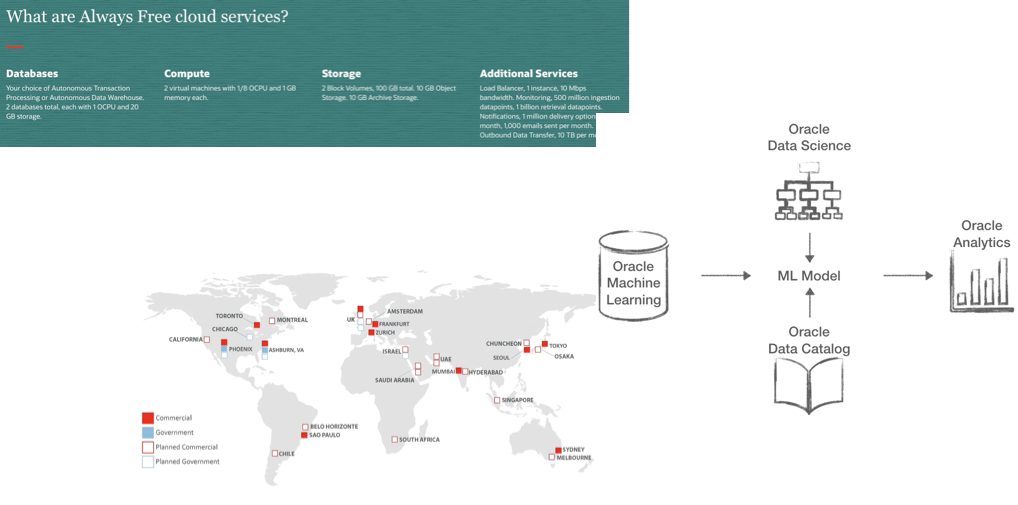OOW 2019 Review: Free Tier, New Datacenters and a New End-to-End Path for Analytics and Data Science

In the Oracle world, last week was "the week" with Oracle Openworld 2019 happening in San Francisco. A week full of exciting news, some of it were also associated with words like "Free", never heard before in any Oracle associated topic. This blog post will go in detail into some of the news with a special focus on the Analytics and Data Science topics.

Oracle Cloud Free Tier
Let's start with the big news: Oracle Cloud Free Tier! A set of services that can ALWAYS be used for free which include Oracle's best offering in the database space like ATP (Autonomous Transaction Processing) and ADW (Autonomous Data Warehouse) as well as Compute, Storage and additional services for networking, monitoring and notifications.

This is a huge news in Oracle ecosystem since it enables everyone to start using the products without the need of a credit card! The always free schema can be also used in conjunction with the 30-day Free Trial (with associated 300$ in credits) to experience the full set of Oracle products without spending a single cent.

An additional interesting point (compared to previous Oracle's developer licensing models) is that there is nothing in the licensing terms blocking any customer to use the free tier for production usage! This means that potentially, if the resources provided satisfy the business requirements, anyone could potentially run production applications directly on the free tier! And, in cases when an upscale is needed, Oracle will provide a very easy option to switch from a free instance to a paid one.
However, as one can expect, the free tier has limitations, for example the databases will allow only 1 OCPU and 20GB of Storage each. On top of the technical limitation, for any of the products in the free tier there is no support and no SLAs. This means, for example, that in case of problems, you'll not be able to open a ticket to Oracle support. Something definitely to ponder about when implementing a production system.
OCI Gen2 and New Datacenters
During his Keynote, Larry Ellison also announced the plan to launch 20 new OCI Gen2 datacenters in the next year! An average of a new datacenter every 23 days!

This is very impressive and, as mentioned during the Keynote, will mean Oracle overtake Amazon for the number of datacenters. A particular mention needs to be given also to the OCI Gen2, the new version of Oracle Cloud Interface. The first generation of OCI mission was the pay per usage: offering a set of services available on demand and payable by hour. The OCI Gen2 adds the autonomous features to Gen1: services are now self-managed, self-patched, self-monitored, self-secured with no downtime required. OCI Gen2 removes a huge set of activities from the hands of administrators taking the human error out of the equation.
Analytics & Data Science
I had a talk on how to Become a Data Scientist with Oracle Analytics Cloud. The topic of Analytics & Data Science was really what interested me most, and my expectation for exciting news was met.
A whole new set of products will be shipped soon, making the whole Data Science experience more continuous and pervasive across the Oracle Products. Let's have a look at the news, I'll try to add links to the relevant sessions I attended.
- Oracle Machine Learning: ML will be more pervasive in the Oracle Database, the Oracle Machine Learning Notebooks will be capable of handling R and Python in addition to SQL. All of this will be available on the Cloud Databases including ADW. A new Spark option is also coming enabling Machine Learning on the BDA.
- Oracle Data Science: This is a brand new product for Data Science collaboration, work in team on projects, with sharing and versioning options available out of the box.
- Oracle Data Catalog: Again a new product aimed at creating inventories of company's data assets and make them searchable and easily usable by business users or data scientist.
- Oracle Analytics Cloud: A lot of new announcements for this product which is mature and consolidated in the market, like Natural Language Generation or enhancements in the Data Enrichment, which I'll address in a separate blog post.
An interesting feature is AutoML, available both in Oracle Machine Learning and Oracle Data Science, which removes some barriers to Data Science by automating most of the steps in the Machine Learning model creation such as model and feature selection, and hyper-parameters tuning.

You might notice several enhancements in different products. However, the key indicator of Oracle's Data Science maturity is the fact that all of the products above can be easily combined! Oracle Data Science will use Oracle Machine Learning optimizations when running on supported platforms on top of datasets easily discoverable by Oracle Data Catalog. Machine Learning models developed by OML or ODS can then be exposed and used by Oracle Analytics Cloud. This provides an end to end path from data scientist to data analyst and business user all within the same toolset and on top of the best hardware (with support for GPUs coming)!

All in all a great OOW full of exciting news: no more barriers to access Oracle Cloud with the free tier, 20 new datacenters coming in the next year and a set of tools to perform Data Science, from the Analyst to the Data Scientist, in a collaborative and extremely performant way! If you want to have more news regarding Oracle Analytics Cloud, don't miss my next blog post (edit: available here)!
